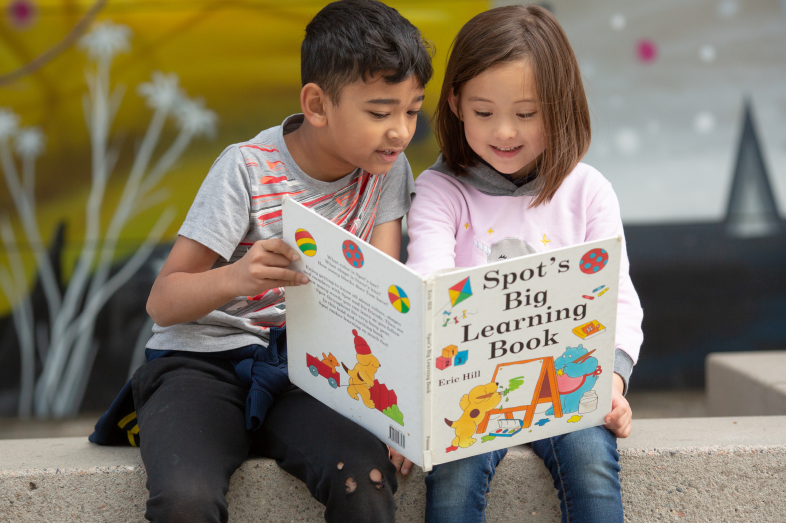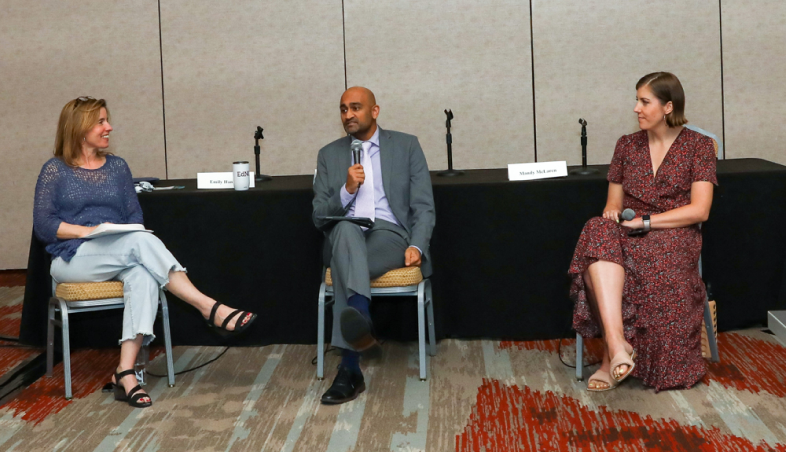
Covering How Students Learn to Read: Tips to Get Started
“Don’t let this story go.” Experienced reporters share advice on covering how students learn to read.
Photo credits: Allison Shelley for EDUimages; Jimmy Minichello of AASA

“Don’t let this story go.” Experienced reporters share advice on covering how students learn to read.
Photo credits: Allison Shelley for EDUimages; Jimmy Minichello of AASA
Despite its complicated research and politics, how students are taught to read is a vital story that reporters can’t afford to let go.
Emily Hanford of APM Reports, Rupen Fofaria of EdNC, and Mandy McLaren of The Boston Globe shared this message at the Education Writers Association’s 2023 National Seminar in Atlanta.
Each shared their journey reporting on literacy and the “science of reading,” along with reporting tips.
Here’s the advice they offered:

Start with one story, the panelists said. Read the research, and understand it enough to vet sources.
“Don’t let this story go,” Hanford said.
Fofaria and McLaren both credited Hanford’s body of work, including her recent podcast “Sold a Story,” for informing their work and pushing them to keep going.
“This topic,” McLaren said, “is extremely complex. It’s frustrating. You want to give up all the time.”
But it’s important, she said, because of students like those she saw in her own classroom as a middle school teacher. These students had been held back but still never learned to read, McLaren explained.
Fofaria, a former lawyer who participated in EWA’s New to the Beat program, said his motivation was a childhood friend who, like himself, often got in trouble.
But Fofaria knew how to read, and his friend didn’t. Fofaria became a lawyer and a journalist;his friend never finished high school and spent much of his life in the criminal justice system.
Hanford, who noted she has the luxury of time and a medium that calls for simplicity in storytelling, said her work has revolved around a few “ah-ha” moments.
“Even really smart kids have a hard time learning how to read,” she found.
There was a gap, she said, between research and practice, and journalists played a role in that gap staying wide.
“In fact, many schools are actually teaching kids the habits of struggling readers, which was a really big takeaway,” she said. “Instruction in schools is actually hurting some children. Not just kids with dyslexia.”
But some students have a safety net, she said: If it’s affordable, their parents can tutor them at home, pay a tutor, or send them to a private school.
“There’s a story here about wealth,” she said. “Some kids are getting the help they need outside of school, and some kids aren’t.”
When Fofaria started reporting on reading, he visited a classroom and thought everything seemed great, with students seemingly engaged, he said.
But he later realized the practices he saw that day weren’t aligned with research, and it made him rethink his approach.
“It just went to show, this isn’t going to be something that I can go into classrooms and identify,” he said. “I have to go and dig into the research, and I did.”
McLaren, who completed a project on the science of reading, “Between the Lines,” while at The Courier Journal, told her editor, there would be no “both sides” of this issue. Reporters should have this conversation early with their editors, she recommended. The series was a 2022 National Awards for Education Reporting finalist in investigative & public service reporting (midsize newsroom).
“I’m not going to write this like, ‘One side says this, but the other side says this. You figure it out’,” she said.
But still, she said, her confidence could be easily shaken.
“Every side has their own research that they want to throw at you, and it can get very confusing, and you can want to retreat on it,” McLaren said.
Hanford pushed reporters to understand the research on how students learn to read is settled, and in large part because of her work on the subject, many of the major players she had called out for their practices were retreating and revising their products.
Still, she acknowledged she and her work have faced criticism.
There are those who don’t believe the research or don’t understand it, she said. Others agree with the research but didn’t like that the “Sold a Story” podcast focused so heavily on phonics, and less on the other parts of learning to read, such as fluency and comprehension, that are also important.
But phonics is the piece that’s been missing, she said, and the goal was to combat “this idea” that students could largely learn to read without it, without being given explicit, direct, cumulative instruction.
In covering legislation related to literacy, the panelists encouraged journalists to look at implementation as much as the law itself.
Are teachers being trained and then coached? Did they have the right tools to implement what they learned about how students learn how to read?
Hanford encouraged reporters not to write stories two years from now with a simple narrative of whether science of reading failed, if test scores don’t suddenly skyrocket. Changing systems is hard, she said.
Journalists, she said, have control over the narrative.
“Keep your eyes on this one, and don’t let this one go,” Hanford said. “Reporters did, I think, largely turn away from how kids learn to read. And I think that’s part of how we ended up in the situation we’re in now. We get to be the watchdogs. We get to be the ones who can contribute to what happens.”
Your post will be on the website shortly.
We will get back to you shortly